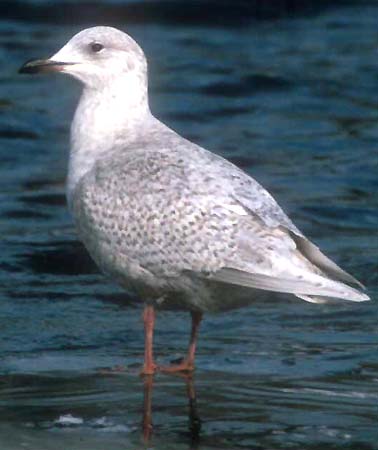THE
MONTEREY COUNTY LIST
Annotated
checklist and data resource
text © Don Roberson
photos copyrighted by photographer(s) credited
all photos taken in Monterey County, California [with one exception
noted]
Thayer's Gull
Larus
thayeri
with comments on Iceland
Gull Larus glaucoides
| Thayer's Gull is an Arctic breeding gull that winters regularly
in MTY. Most arrive in Nov-Dec and depart in Feb-Mar; spring & summer
records are few. A classic basic-plumaged adult is shown below: pale gray
mantle (paler than California Gull; just a tiny bit darker than Herring
Gull), heavily streaked head & neck (in basic plumage), rather short,
thin bill for a largish Larus, bright pink legs, and dark eye (usually;
but see right). |
There is substantial variation in eye color of adults, ranging from
dark to darkish (below top) to quite pale yellowish (below bottom). These
photos of different adults were taken just minutes apart in the same light
conditions in January. Note that both have purplish orbital rings. King
& Howell (1999) showed that most adults have pale brown eyes with extremes
ranging from yellow to dark brown. |
 |
 |
| Where to locate a Thayer's Gull in MTY? Thayer's Gulls in MTY
apparently forage mostly offshore, although some also use the Marina dump.
They are most regularly found, in season, at large gull roosts at Moss
Landing and the Little Sur River mouth. Thayer's are much less common at
other gull roosts, although they are regular in small numbers at Pt. Pinos,
Pebble Beach, Roberts Lake in Seaside, Salinas R. mouth, and Pajaro R.
mouth. |
|
all photos above & below © Don Roberson
except as otherwise indicated
all above: 8 Jan 2004 Moss Landing
|
The standard identification problem in adult Thayer's is separating
it from Herring Gull, the other pale-backed, black-primaried, pink-legged,
large adult Larus gull. The composite (below) compares the
head and bill shape of these two species. I have chosen to use a pale-eyed
Thayer's because dark-eyed Thayer's are less similar to adult Herring Gull:
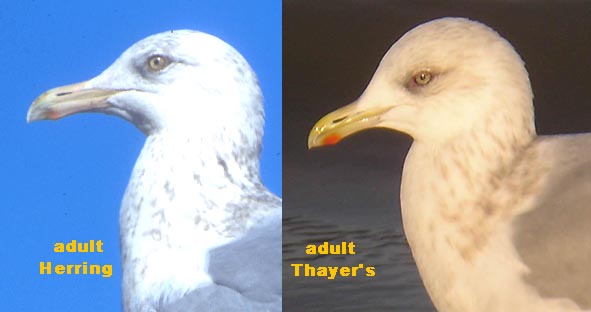 Compare the following features:
Compare the following features:
-
Thayer's had shorter, slimmer bill than Herring. This is a critical field
mark and, once learned, is useful even if flight of birds some distance
away;
-
Thayer's has a "gentler" head profile caused by more rounded forecrown;
Herring looks comparatively angular and therefore "fierce" in comparison.
However, as discussed below, females look more round-headed and short-billed
than males, and large male Thayer's can approach the size and shape of
small female Herring;
-
Adding to the "fierce" aspect of Herring is a very bright angry-yellow
eye surrounded by a yellow orbital ring (bare eye-ring), while the orbital
ring of Thayer's is dull purple or purple-red;
-
Thayer's may have a tendency to have a bit more duskiness around the eye;
-
Thayer's back color is slightly darker than Herring, but this difference
is not apparent in bright sunlight and is better noted on overcast days;
and
-
Thayer's tend to have brighter pink legs (as adults) than Herring, but
this is an "average" difference that is not useful on individual birds.
Head streaking is very variable in winter. Shown here are a February Herring
Gull and a January Thayer's Gull with rather similar head/neck streaking,
but both can have much heavier streaking than this. Later, as they advance
to alternate plumage, they will lose the streaks altogether.
For another nice comparison page of all four winter plumages of Herring
vs. Thayer's Gull, see Greg
Gillson's web site
| For our local MTY purposes, these comparisons are with American Herring
Gull L. argentatus smithsonianus. Many European authorities already
split this taxon as a separate species from various Eurasian subspecies
of Herring Gull, based primarily on biochemical evidence. |
|
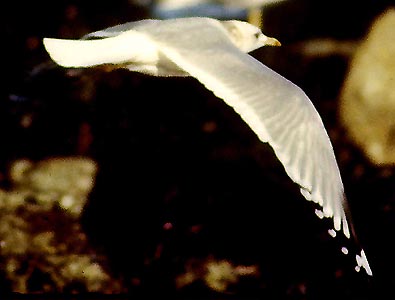 |
In flight, adult Thayer's Gull show restricted black tips to the outer
primaries compared to other large Larus gulls. The white apical
spot is large and prominent on p10 (the outermost primary). In most birds
each outer primary has a mostly black outer web and mostly white inner
web, sometimes giving a "black-and-white striped" effect to the flight
pattern on the outer wing (Lehman 1980, Gosselin & David 1975). There
is much variation in adult wingtip pattern in Thayer's Gull. Sketches in
Snell (2002) are particularly useful as they are linked to known breeding
locations on high Arctic islands, while sketches in Howell & Elliott
(2001) catalogue variation among 123 winter birds in California. You can
see some small variation in the photos on this page, but they do not cover
the known range of variation.
left: 25 Jan 1980 Pt. Pinos |
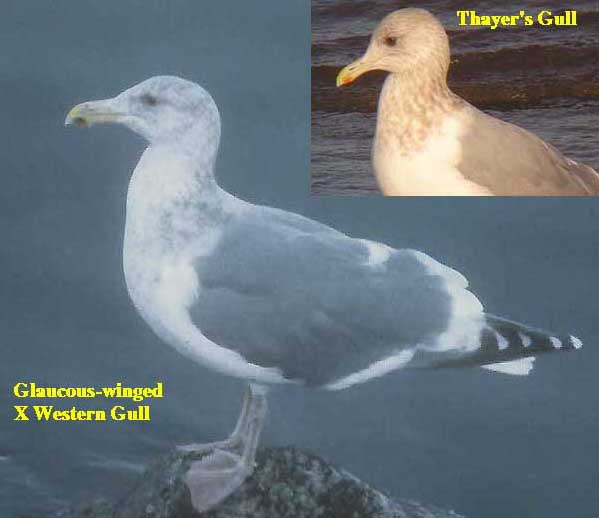
|
Another identification problem faced by MTY birders is separating adult
Thayer's
Gull from adult Glaucous-winged x Western Gull hybrids/intergrades.
Glaucous-winged and Western Gulls hybridize and intergrade widely in w.
Washington and n. Oregon, and many of these birds winter here in MTY. Birders
colloquially call them "Olympic" Gulls. As these are large, pale-backed,
pink-legged, dark-eyed gulls, birders using field guides can easily mistake
an "Olympic" Gull for a Thayer's Gull, especially at Pt. Pinos or Pebble
Beach, where hybrid gulls are common and Thayer's are scarce. In the photos
above, compare these features on adult (all white-tailed) gulls:
-
The introgressant gulls ("Olympic") are big billed with a pronounced, swollen
gonys; Thayer's have slim bills with less swollen gonys;
-
Many "Olympic" gulls, like the one shown here, have extensive smudging
to the head, neck, and sides of breast; Thayer's can be heavily streaked
but they look distinctly streaked, not smudged, except around the eye;
-
"Olympic" Gulls are big-bodied and block-headed — they are the size of
Western and/or Glaucous-winged Gulls while Thayer's is decidedly smaller
and slimmer;
-
The wingtips of "Olympic" Gulls range from slaty to charcoal to dark gray,
but not usually black; on Thayer's, the wingtips are black;
-
"Olympic" Gulls tend to have slightly darker mantles than the pale-mantled
Thayer's;
-
The bills of "Olympic" Gulls often have dark markings while fully adult
Thayer's (i.e., with all-white tails) generally do not; and
-
True adult Thayer's usually have bright pink legs while most intergrades
have duller pink legs.
A more serious problem is separating Thayer's from Glaucous-winged
x Herring Gull hybrids/intergrades. Glaucous-winged and Herring hybridize
widely in southeast Alaska and some of them winter here in MTY. They are
much less common than "Olympic" Gull but some can resemble Thayer's Gull
more closely. Adult Glaucous-winged x Herring Gull hybrids tend to be larger
than Thayer's; have bigger and heavier bills (but can overlap male Thayer's);
tend to have dark markings on the bill; and can have yellowish in the orbital
ring. For more details see Howell & Corben (2000), Howell & Elliott
(2001).
Photo of "Olympic" Gull Nov 1979 Pt. Pinos © Jeri
M. Langham; inset Thayer's same bird as first shot at top |
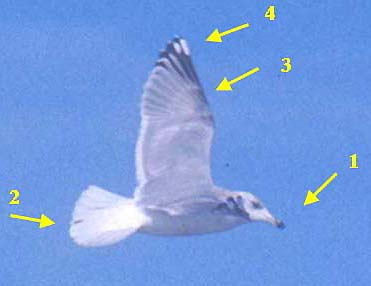 Thayer's Gull is a four-year gull. A third-winter bird is shown above in
flight (upper right in preceding panel) and to the left. Note these points
that are different than adults:
Thayer's Gull is a four-year gull. A third-winter bird is shown above in
flight (upper right in preceding panel) and to the left. Note these points
that are different than adults:
-
Bill still two-tone or pale with black ring near tip;
-
Dark spots in otherwise while tail;
-
Duskiness on primary coverts; and
-
Primary pattern with more black (and less white) than full adults.
Howell & Elliott (2001) recently showed that the extent of white in
the outer primaries increases in each molt during years 3 through 7. Further,
one must always recognize that our discussion of plumage (e.g., the idea
that this is a "third-year" bird) refers to plumage, not age. Studies of
known age gulls have shown that individual birds may be actually a year
older or a year younger than is suggested by their plumage state (Monaghan
& Duncan 1976). |
| Thayer's in second basic plumage (=2nd Winter; right) are identified
by pale gray back, size, head and bill shape, all-dark tail, dark tertials,
and black primaries. The bill is two-toned as typical in most large second-winter
gulls.
right: 8 Jan 2004 Moss Landing; © D. Roberson |
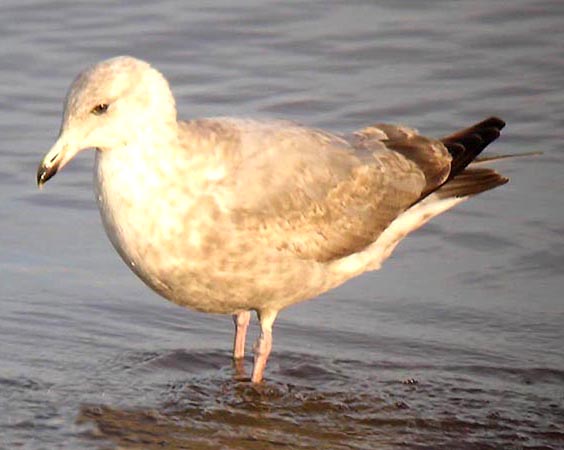 |
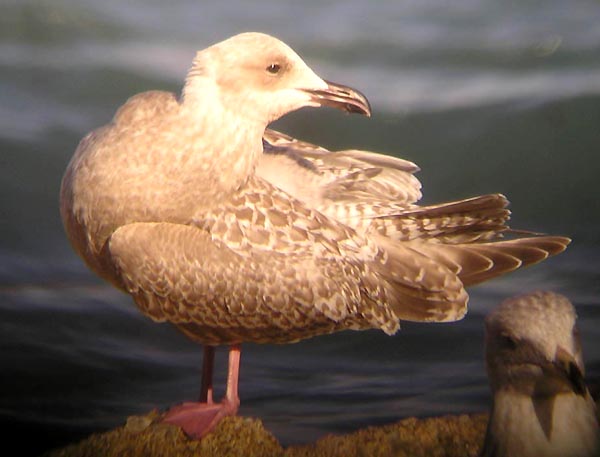 |
Thayer's Gull retains juvenal plumage well into the winter; often birds
in Feb or Mar are still in full juvenal plumage, as is this Jan bird (left).
There is much variation in juvenal plumage from dark birds to light birds;
this one is a darkish individual with dark brown (but not black)
primaries, mostly dark tertials, a darkish eye patch, and typical Thayer's
bill shape (short; it looks a little thick here only because the bill is
slightly open to preen its feathers). Same bird is below, right-hand bird.
left & below right: 11 Jan 2004 Pebble Beach
below left: 7 Feb 2004 Roberts Lake |
In juvenal plumage there is a wide range of variation between paler birds
and darker birds; those below might be called "mid-range" (left) to darker
end (right). There is much variation in details of tertial pattern but
Thayer's do tend to have dark-centered tertials. There is also size and
bill variation due to sexual dimorphism: the left-hand bird below is probably
a larger billed male and the right-hand bird a smaller billed female. As
noted by Zimmer (1990), our "image" of the jizz of Thayer's Gull is probably
based on a more delicate, dove-headed female rather than on both sexes,
and this bias can temper our analysis of birds in the field.
As in adults, the main identification problems with juvenal-plumaged Thayer's
Gulls in their first winter is with similar aged Herring Gulls and hybrid/introgressant
Glaucous-winged x Western Gulls (below).

|
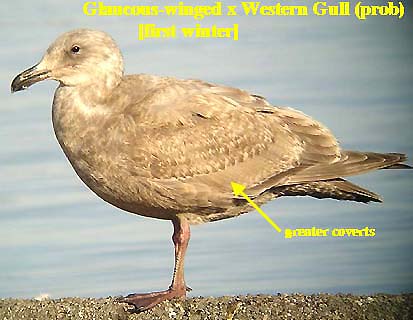
|
First-winter Herring Gulls differ from Thayer's by:
-
Herring is a bit larger and heavier-billed, but I've chosen to illustrate
what is likely a small female Herring (above) to minimize this character;
-
Herring is black-winged; Thayer's has brownish to tan primaries;
-
The bill of first-year Herring becomes pink at the base much earlier than
Thayer's, so mid-winter birds with pink bases are likely Herring while
Thayer's shows only the barest hint of of paleness well into winter;
-
Herring often looks decidedly white-headed in its first winter; Thayer's
does not;
-
Herring tends to have a less-checkered pattern to the wing coverts; Thayer's
looks quite checkered and can sometimes be dramatically checkered; and
-
Herring tends to show show new gray feathers to back (pre-alternate molt
using terminology of Howell 2001) and thus is molting out of juvenal plumage
by mid-winter, while Thayer's remains in juvenal plumage throughout the
winter and often well into spring.
Photo above 10 Feb 2004 Pt. Pinos; © Don Roberson |
First-winter intergrades or hybrids of Glaucous-winged x Western Gull
("Olympic" Gulls), of which the photo above shows a probable individual,
can recall Thayer's because they have brownish (not black) wingtips. Among
the ways they differ from Thayer's are:
-
"Olympic" Gull is much larger than Thayer's; it is size of Glaucous-winged
or Western
-
"Olympic" Gull has much heavier bill with swollen gonys
-
The greater coverts (yellow arrow points to this set of feathers) are typically
unpatterned and plain; Thayer's has very patterned and checkered greater
coverts
-
"Olympic" Gulls are in molt much earlier than Thayer's and usually look
worn or ratty, rather than having the crisp patterns of unmolted, juvenal-plumaged
Thayer's Gulls
Remember that here in MTY, "Olympic" Gulls are more common than Thayer's
Gull at popular sites like Pt. Pinos or Roberts Lake.
Photo above 7 Feb 2004 Roberts Lake, Seaside; © Don
Roberson |
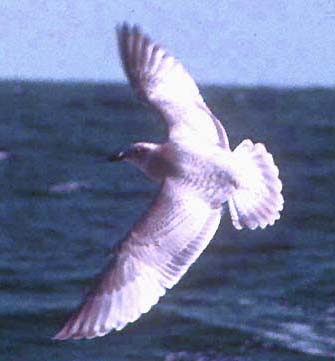 In
flight, juvenal Thayer's Gull recalls Glaucous-winged Gull because the
primaries are not black. and many birds, like this one, have paleish tan
primaries than give a translucent feel. Thayer's is a smaller gull overall
than Glaucous-winged, and note particularly the distinctive tail band effect
(Glaucous-winged has a uniform tail in juvenal & 1st winter plumage).
Note also the short, slim bill and delicate head, rather than the big-billed,
big-headed look of Glaucous-winged Gull. In
flight, juvenal Thayer's Gull recalls Glaucous-winged Gull because the
primaries are not black. and many birds, like this one, have paleish tan
primaries than give a translucent feel. Thayer's is a smaller gull overall
than Glaucous-winged, and note particularly the distinctive tail band effect
(Glaucous-winged has a uniform tail in juvenal & 1st winter plumage).
Note also the short, slim bill and delicate head, rather than the big-billed,
big-headed look of Glaucous-winged Gull.
As winter progresses, young Thayer's become more worn and can look almost
"white winged" by late February, like this one on Crespi Pond (below).
Most remain in juvenal plumage well into spring and, like other high latitude
gulls, there is no pre-basic molt in the first winter (Howell, King &
Corben 1999). Almost all depart MTY by the end of March, with only a few
migrants noted later in spring.
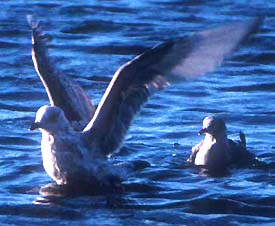
right 17 Nov 1979 ~50 nmi SW of Cape San Martin; above 24
Feb 1998 Crespi Pond; both © D. Roberson |
The Kumlien's konundrum: As the AOU taxonomy currently (2004)
stands, Thayer's Gull is considered closely related to Iceland Gull L.
glaucoides, and this latter species has two races: nominate glaucoides
(nesting
mostly in Greenland) and kumlieni (nesting mostly in extreme northeastern
Canada). There is much current debate as to whether Thayer's/Iceland should
be considered a single variable species, and whether the taxon kumlieni
is a hybrid population between nominate glaucoides (to the east)
and thayeri (to the west). Some studies support this scenario; others suggest
that biochemically these groups are not each other's closest relatives.
There is still much to be learned about the relationship and taxonomy of
these groups, which have a long and checkered history (Pittaway 1999).
There is abundant evidence, however, that a few gulls, mostly juvenals,
from eastern populations within the range of kumlieni occur as rarities
along the west coast of North America. Identifying such vagrants has been
a major challenge and the subject of long debate [e.g., see my earlier
page on an apparent
Kumlien's in Orange Co., California, and also read the contrary opinions].
In Monterey County there have been several claims of Iceland Gull, presumably
assignable to Kumlien's, including a specimen at U.C. Davis and several
sight records. My own evaluation of these is that only one was probably
Kumlien's: a small, dainty, frosty-white juvenal at Moss Landing 15-20
Feb 1998, discovered by Rich Stallcup. My photos of (presumably) this bird
on 17 Feb 1998 are below. They have been enlarged to the limits of the
film. Compare these with a known juvenal Iceland for Connecticut, shown
on purple background to the right:
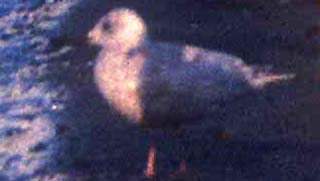
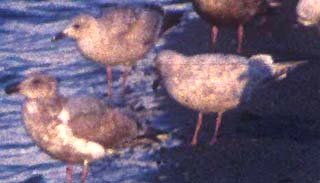
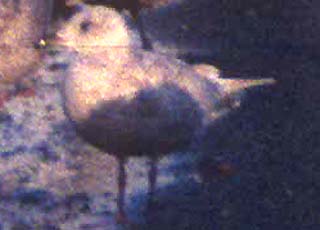 |
Three different views of the MTY bird 17 Feb 1998 are shown to the
left; the bird below is a juvenal Kumlien's Iceland Gull from Connecticut
[© Louis Bevier 15 Dec 1986]. This East Coast bird, bordered in purple,
is the only photo on this page not taken in Monterey Co.
On the CT bird note the very white primaries with slight dusky spots at
the tips; the pale and thinly-barred tertials; the dainty but pot-bellied
shape; and the very "dove-headed" appearance. |
| It is difficult to directly analyze the MTY bird because the photos
are so distant and not crisp. To my eye, the bill size, shape, and color
pattern (slight pale to base of lower mandible) is very similar, and to
my eye the MTY bird is "dove-headed." However, to me it looks less pot-bellied
and looks longer-legged than the CT bird. It is difficult to determine
the exact primary and tertial pattern of the MTY bird, and we can't see
the tail pattern at all. My field notes describe the primaries as pale,
frosty "coffee-with-cream-colored;" the tertials as also pale coffee-colored;
and the tail in flight as having "ghost image" of a tail band created by
fine mottling on the whitish tail. I did not note a secondary bar in flight;
note that in the middle photo the pale bird is next to a "dark-end" Thayer's
above it and to its left with blackish primaries and secondary bar apparent.
The February 1998 MTY bird was evaluated by details over the Internet
on "I.D. Frontiers." It was evaluated by almost all East Coast birders
as being well within the range of Kumlien's Iceland Gull, but it was almost
near unanimously rejected by the California Bird Records Committee. To
date, the only CBRC-accepted juvenal-plumaged Iceland Gull has been an
entirely white-winged bird in San Diego Co. in Jan 1986. [I also saw that
bird.]
My own view is that the February 1998 MTY bird likely originated from
within the population in eastern Canada that is currently assigned to Kumlien's
Iceland Gull (e.g., see Zimmer 1991, Snell 2002). However, it is not quite
a "classic" Iceland, and is thus best left undetermined. In my book Monterey
Birds 2d ed. (2002) it is discussed but not included on the official
MTY checklist. For more on Kumlien's Gull, see Zimmer (1991), Snell (2002),
and Howell & MacTavish (2003). |
Bibliography: these are probably the most important and/or accessible
text references to date. Much additional information is available on line;
see my links [find
the gull specialty sites in the list]:
Gosselin, M., and N. David. 1975. Field identification of Thayer's
Gull (Larus thayeri) in eastern North America. American Birds 29:1059-1066.
Howell, S.N.G. 2001. A new look at moult in gulls. Alula 7:2-11.
Howell, S.N.G., and C. Corben. 2000. Identification of Thayer's-like
gulls: the Herring x Glaucous-winged Gull problem. Birders Journal 9:25-33.
Howell, S.N.G., and M.T. Elliott. 2001. Identification and variation
of winter adult Thayer's Gulls with comments on taxonomy. Alula 4:130-144.
Howell, S.N.G., J.R. King, and C. Corben. 1999. First prebasic molt
in Herring, Thayer's, and Glaucous-winged Gulls. J. Field Ornithology 70:543-554.
Howell, S.N.G., and B. MacTavish. 2003. Identification and variation
of winter adult Kumlien's Gulls. Alula 6:2-15.
King, J.R., and S.N.G. Howell. 1999. Featured photo: variation in iris
color of adult Thayer's Gull. Western Birds 30:55-56 (and back cover).
Lehman, P. E. 1980. The identification of Thayer's Gull in the field.
Birding 12:198-210.
Monaghan, P., and N. Duncan. 1976. Plumage variation of known-age Herring
Gulls. British Birds 72:100-103.
Pittaway, R. 1999. Taxonomic history of Thayer's Gull. Ontario Birds
17:2-13.
Snell, R.R. 2002. Iceland/Thayer's Gull (Larus glaucoides/thayeri)
in
The Birds of North America, No. 699 (A. Poole & F. Gill, eds.). The
Birds of North America, Inc., Philadelphia, PA.
Zimmer, K. J. 1990. "The Thayer's Gull complex," pp. 114-130 in
Field Guide to Advanced Birding by K. Kaufman. Houghton Mifflin, Boston.
Zimmer, K. J. 1991. Plumage variation in "Kumlien's" Iceland Gull.
Birding 23: 254-269.
Use these links to reach other portions of the Monterey County list:
Part 1: Waterfowl
through Grebes
Part 2: Albatrosses
through Frigatebirds
Part 3: Herons
through Cranes
Part 4: Plovers
through Sandpipers
Part 5: Jaegers
through Alcids
Part 6: Doves
through Woodpeckers
Part 7: Flycatchers
through Larks
Part 8: Swallows
through Pipits
Part 9: Waxwings
through Warblers
Part 10: Tanagers
through Sparrows
Part 11: Grosbeaks
through Finches
or just the plain Checklist
(no annotations)
Readers may use this material for their own private enjoyment,
study, or research but none of the photos or text herein may be used commercially
nor may they be reposted on other web sites without written permission.
All material is copyrighted. The posting of photos and text on this private
web site is not a submission to review organizations.
TOP
TO HOME PAGE
TO
MONTEREY COUNTY LIST PORTAL PAGE
TO MONTEREY COUNTY
PAGE
TO BIRD FAMILIES
OF THE WORLD
Page created 24 Jan-20 Feb 2004




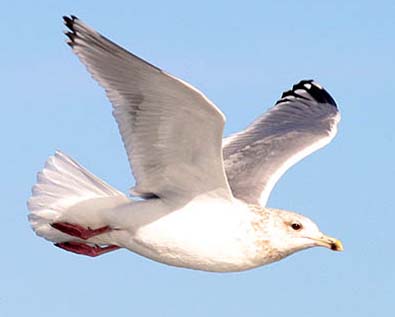



 Thayer's Gull is a four-year gull. A third-winter bird is shown above in
flight (upper right in preceding panel) and to the left. Note these points
that are different than adults:
Thayer's Gull is a four-year gull. A third-winter bird is shown above in
flight (upper right in preceding panel) and to the left. Note these points
that are different than adults:


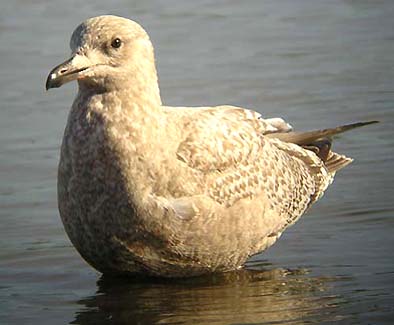
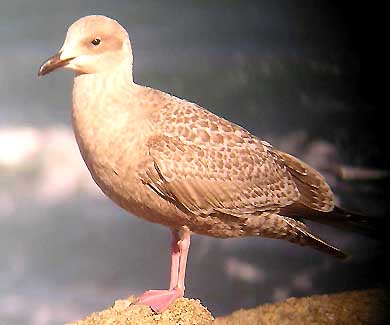


 In
flight, juvenal Thayer's Gull recalls Glaucous-winged Gull because the
primaries are not black. and many birds, like this one, have paleish tan
primaries than give a translucent feel. Thayer's is a smaller gull overall
than Glaucous-winged, and note particularly the distinctive tail band effect
(Glaucous-winged has a uniform tail in juvenal & 1st winter plumage).
Note also the short, slim bill and delicate head, rather than the big-billed,
big-headed look of Glaucous-winged Gull.
In
flight, juvenal Thayer's Gull recalls Glaucous-winged Gull because the
primaries are not black. and many birds, like this one, have paleish tan
primaries than give a translucent feel. Thayer's is a smaller gull overall
than Glaucous-winged, and note particularly the distinctive tail band effect
(Glaucous-winged has a uniform tail in juvenal & 1st winter plumage).
Note also the short, slim bill and delicate head, rather than the big-billed,
big-headed look of Glaucous-winged Gull.




